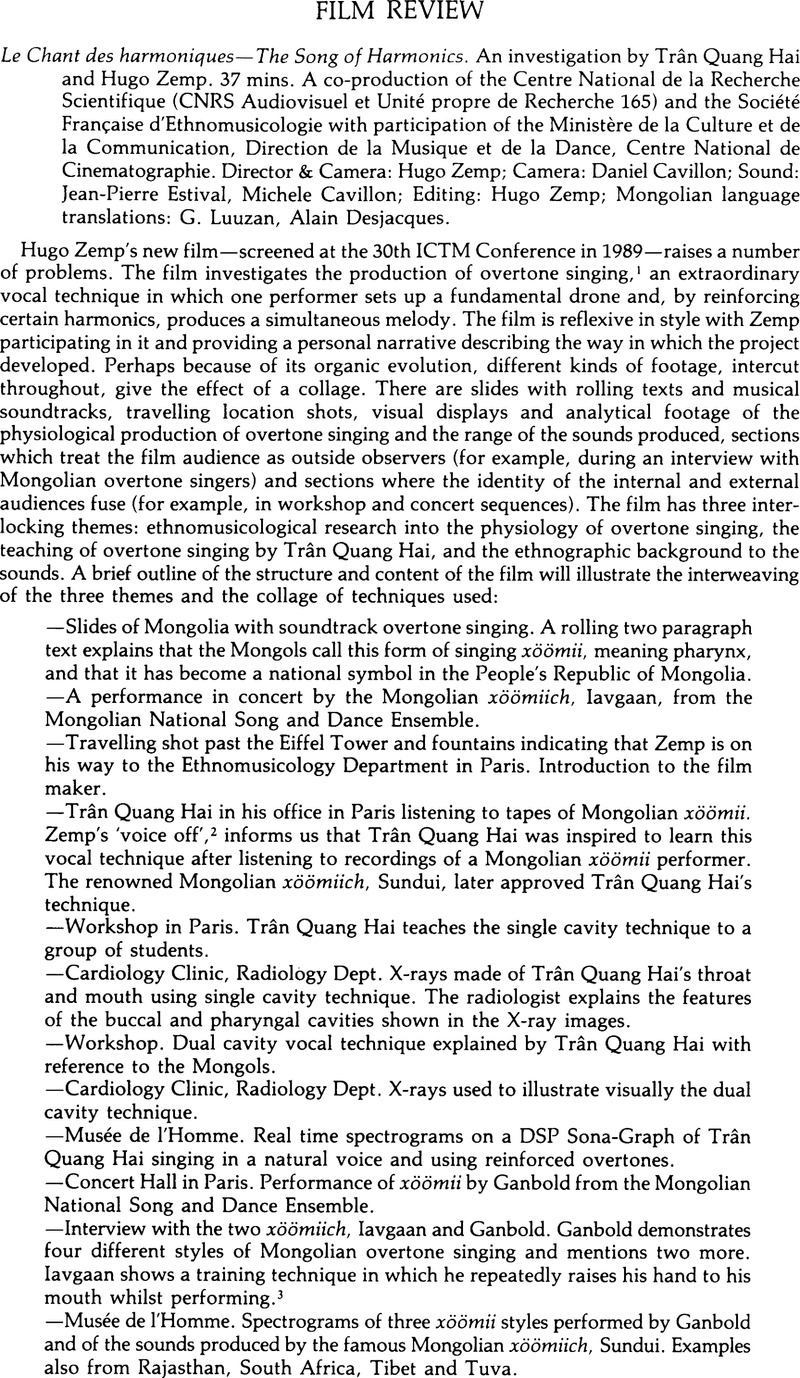No CrossRef data available.
Article contents
Le Chant des harmoniques—The Song of Harmonics. An investigation by Trân Quang Hai and Hugo Zemp. 37 mins. A co-production of the Centre National de la Recherche Scientifique (CNRS Audiovisuel et Unité propre de Recherche 165) and the Société Française d'Ethnomusicologie with participation of the Ministère de la Culture et de la Communication, Direction de la Musique et de la Dance, Centre National de Cinematographie. Director & Camera: Hugo Zemp; Camera: Daniel Cavillon; Sound: Jean-Pierre Estival, Michele Cavillon; Editing: Hugo Zemp; Mongolian language translations: G. Luuzan, Alain Desjacques.
Review products
Le Chant des harmoniques—The Song of Harmonics. An investigation by Trân Quang Hai and Hugo Zemp. 37 mins. A co-production of the Centre National de la Recherche Scientifique (CNRS Audiovisuel et Unité propre de Recherche 165) and the Société Française d'Ethnomusicologie with participation of the Ministère de la Culture et de la Communication, Direction de la Musique et de la Dance, Centre National de Cinematographie. Director & Camera: Hugo Zemp; Camera: Daniel Cavillon; Sound: Jean-Pierre Estival, Michele Cavillon; Editing: Hugo Zemp; Mongolian language translations: G. Luuzan, Alain Desjacques.
Published online by Cambridge University Press: 07 March 2019
Abstract
An abstract is not available for this content so a preview has been provided. Please use the Get access link above for information on how to access this content.

- Type
- Film Review
- Information
- Copyright
- Copyright © 1992 by the International Council for Traditional Music
References
References Cited
Aksenov, A.N. 1973 “Tuvin Folk Music.” Asian Music 4, 2: 7–18 [extract from Tuvinskaya narodnaya muzyka 1964. Moscow.]CrossRefGoogle Scholar
Gunji, S. 1980 “An Acoustical Consideration of Xöömij.” In Musical Voices of Asia, Report of Asian Traditional Performing Arts 1978, eds. Emmert and Minegishi, 135-141. Tokyo Heibonsha Publishers.Google Scholar
Léothaud, G. 1989 “Considérations acoustiques et musicales sur le chant diphonique.” In Le chant diphonique. Dossier No. 1. Institut de La Voix. Centre Pluridisciplinaire de Recherche et de Diffusion, 17-44. Limoges.Google Scholar
Maslov, V.T. & Chernov, B.P. 1979-80 “The Secret of the ‘Solo Duet'.” Soviet Anthropology and Archaeology 18, 3: 82–86.Google Scholar
Pegg, C.A. 1992 “Mongolian Conceptualisations of Overtone Singing (xöömii).” British Journal of Ethnomusicology (in press).CrossRefGoogle Scholar
Smith, H., Stevens, K.N. & Tomlinson, R.S. 1967 “On an Unusual Mode of Chanting by Certain Tibetan Lamas.” The Journal of the Acoustical Society of America 41, 5: 1262–1264.CrossRefGoogle Scholar
Trân, Q.H. & Guillou, D. 1980 “Original Research and Acoustical Analysis in Connection with the Xöömij Style of Biphonic Singing.” In Musical Voices of Asia (as for Gunji, above): 162–173.Google Scholar
Vainshtein, S.I. 1978-79 “A Musical Phenomenon Born in the Steppes.” Soviet Anthropology and Archaeology 18, 3: 68–81.CrossRefGoogle Scholar
Walcott, R. 1974 “The Chöömij of Mongolia. A Spectral Analysis of ‘Overtone Singing'.” Selected Reports in Ethnomusicology 2, 1: 55–59.Google Scholar
Zemp, H. 1988 “Filming Music and Looking at Music Films.” Ethnomusicology 32: 393–427.CrossRefGoogle Scholar
1989 “Filming Voice Technique: The Making of ‘The Song of Harmonics'.” The World of Music 30: 56–85.Google Scholar
1990 “Visualizing Music Structure through Animation: The Making of the Film ‘Head Voice, Chest Voice'.” Visual Anthropology 3, 1: 65–79.CrossRefGoogle Scholar
Zemp, H. & Trân, Q.H. 1991 “Recherches experimentales sur le chant diphonique.” Cahiers de musiques traditionelles 4: Voix, 27–68.Google Scholar


